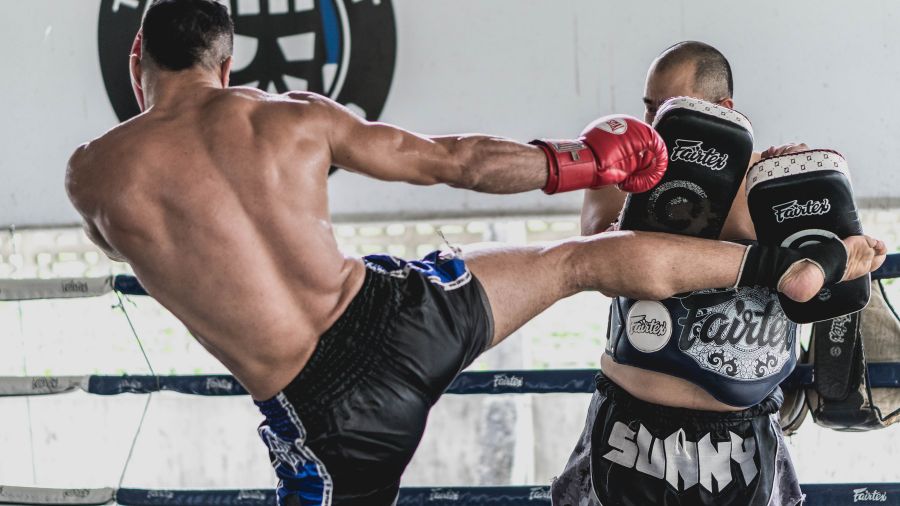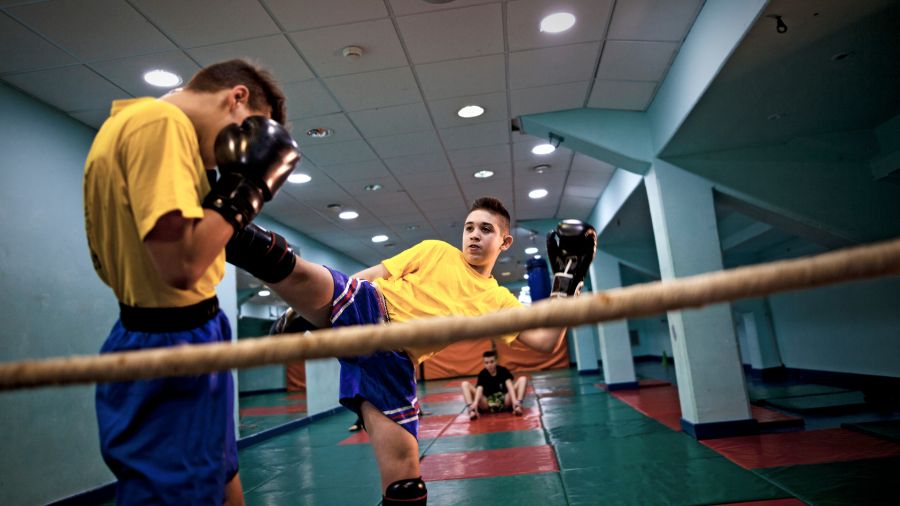Kicks are devastating weapons within martial arts. As Joe Rogan has said, it’s like taking a baseball bat to the head or thigh. While practicing and perfecting kicking technique is a way to develop power, there is much more you can do to have devastatingly hard kicks and chop down the heavy bag.
7 Ways To Kick Harder For Muay Thai & Kickboxing
You can instantly implement these 7 tips within your training week and should be using most of these to kick harder and faster.
Develop Lower Body Maximal Strength
The power generated when kicking starts from the ground. The determinants of kicking hard are similar to punching hard. Being able to generate forces with the legs and transfer that force through rotating the hips and trunk.
Therefore, generating high forces with the lower body is critical for kicking harder. Typical exercises like the squat, deadlift, hip thrust, leg press, and single leg variations all fit this category.
However, Muay Thai, kickboxing, and MMA are weight-class sports. Adding significant muscle mass will make your weight cut harder, and extra mass can potentially negatively affect your conditioning. Therefore, training volumes should be low, and sets should be stopped far from failure since training volume and effort heavily influence muscle growth [1][2].
Discover The Little Known Secrets For Unlocking Devastating KO Power!
Heavy hands are built doing these things...
For example, 2-3 sets of 2-5 reps are more than enough to stimulate strength gains as long as the load is heavy enough. Typically, above 80% 1RM.
Another option is using overcoming isometrics. Also known as maximal isometrics. For example, a maximal deadlift from the mid-thigh position, but the bar is fixed against the rack. Pull for 6 seconds as hard and fast as possible.
This type of training doesn’t stimulate the same hypertrophic response as isotonic strength exercise (concentric-based exercises like the squat).
Develop Explosive Power With Jumps & Plyometrics

Being strong is great. But maximal strength is void of a time constraint, which is why Powerlifters are brutally strong but often lack the ability to display it quickly through athletic tasks. Kicking in martial arts comes with time constraints.
The faster you can kick, the less time your opponent has to react. But the adaptations from maximal strength training oppose the adaptations from explosive training even though maximal strength is highly related to producing force quickly [3].
For example, maximal strength training increases co-contractions around the joints, which is a protective mechanism. However, it reduces speed. Explosive training reduces joint co-contractions allowing the limbs to move quickly.
It’s well known that elite athletes don’t produce more force than sub-elite athletes. Still, they can relax antagonist muscles faster. This rapid “on-off” contraction is how you can kick harder and faster.
Jumps and plyometrics are your tickets to explosive kicks. Jumps can be loaded or unloaded, and plyometrics are typically performed with bodyweight only. Place more emphasis on jumps for explosive kicking power and plyometrics for overall leg health.
Build Rotational Strength & Power
Bracing the trunk muscles and using them effectively to transfer and generate rotational forces is paramount to kicking harder. While this hasn’t been directly studied, it has been within Muay Thai knees.
A 6-week core training program of isometric or dynamic training increased knee impact forces by 13.1 and 7.1%, respectively [4]. While knees aren’t kicks, it suggests that developing core strength can potentially improve lower body striking power.
To do this, use a mixture of heavy-loaded strength-based rotational and ballistic exercises. For example, seated plate and landmine rotations take care of the heavy-loaded strength exercise. Heavy medicine ball rotational throws also fit here.
You can use various lighter medicine ball throws to help sequence the force generated from the legs and through the trunk to develop speed and power.
Use Resistance Band Kicks

I’ll preface this section by saying resistance band kicks may not be the best idea and are not often used because they may negatively affect technique. But from a purely physical standpoint, resistance band kicks increased roundhouse kick force by 20-33% in Taekwondo athletes after 6 weeks of training [5].
Perform HIIT With Kicks
This has been extensively studied within punching forces. That is, 14 x 3 seconds of all-out punches with 10 seconds rest resulted in harder punches [6]. We would likely see the same results if replacing punches with kicks.
Kick Often
Kicking is a skill that must be developed and mastered. If you’re new to kickboxing, Muay Thai, MMA, or Taekwondo, your kicks won’t have the deafening thud a more experienced practitioner will have. No matter how much stronger you may be.
Mastering kicking technique will also make you more efficient and less likely to gas out when throwing multiple roundhouse kicks. Further, combining technical and strength training within a week significantly increases kicking power by 7-34% [7].
Oscillatory Isometrics
A recently published review by friend and colleague Aaron Uthoff calls these action braking, clamping complex (ABC complex) exercises [8]. You can listen to Aaron talk about these and much more on the Sweet Science of Fighting podcast below:
They consist of rapid eccentric concentric transitions that facilitate the antagonist muscle relaxation reducing co-contractions around the joint. Similar to explosive and plyometric training explained earlier in the article but focused on different muscle groups without ground impacts.
Here is an excellent example from Graeme Morris of a split squat ABC complex below:
Summary
Don’t get stuck in the mindset that lifting weights will make you “bulky and slow.” Sure, if you run a complete bodybuilding program, you’ll run into this problem. But developing strength and explosive power will transfer to kicking harder, especially when kicking often in training.
References
1. Schoenfeld, B. J., Ogborn, D., & Krieger, J. W. (2017). Dose-response relationship between weekly resistance training volume and increases in muscle mass: A systematic review and meta-analysis. Journal of sports sciences, 35(11), 1073-1082.
2. Schoenfeld, B. J., Grgic, J., Van Every, D. W., & Plotkin, D. L. (2021). Loading recommendations for muscle strength, hypertrophy, and local endurance: a re-examination of the repetition continuum. Sports, 9(2), 32.
3. Andersen, L. L., & Aagaard, P. (2006). Influence of maximal muscle strength and intrinsic muscle contractile properties on contractile rate of force development. European journal of applied physiology, 96(1), 46-52.
4. Lee, B., & McGill, S. (2017). The effect of core training on distal limb performance during ballistic strike manoeuvres. Journal of Sports Sciences, 35(18), 1768-1780.
5. Topal, V., Ramazanoglu, N., Yilmaz, S., Camliguney, A. F., & Kaya, F. (2011). The effect of resistance training with elastic bands on strike force at Taekwondo. Am Int J Contemp Res, 1, 140-4.
6. Kamandulis, S., Bruzas, V., Mockus, P., Stasiulis, A., Snieckus, A., & Venckunas, T. (2018). Sport-specific repeated sprint training improves punching ability and upper-body aerobic power in experienced amateur boxers. The Journal of Strength & Conditioning Research, 32(5), 1214-1221.
7. Vecchio, L. D., Stanton, R., Macgregor, C., Humphries, B., & Borges, N. (2019). Effects of a Six-Week Strength and Power Training Program on Punching and Kicking Impact Power in Amateur Male Combat Athletes: A Pilot Study. J Athl Enhanc 8: 1. of, 8, 2.
8. Lenetsky, S., Uthoff, A., Coyne, J., & Cronin, J. (2022). A Review of Striking Force in Full-Contact Combat Sport Athletes: Methods of Assessment. Strength and Conditioning Journal, 44(1), 71-83.


